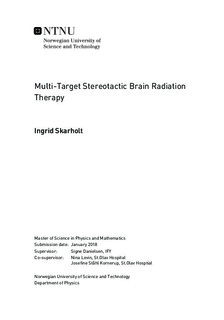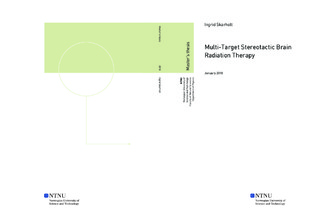| dc.description.abstract | Metastasis of the brain is one of the most common and severe neurological complications of cancer. Stereotactic radiation therapy (SRT) characterized by a high dose of radiation, delivered in a single or few fractions, with conformal target coverage and steep dose-falls, has been shown to be effective in treating brain metastases and recurrence gliomas. Historically, Gamma Knife (GK) has been superior to other SRT-techniques.
However, the increased flexibility of the new generation of linear accelerators (linac), has made linac-SRT
to a competing method. Traditionally, treatment plans for multiple-brain metastases were made with 1
isocenter pr.target. Recent studies using volumetric arc therapy (VMAT) showed about the same target
coverage when optimized with single isocenter.
The aim of this study was to investigate the influence of different linear accelerator models and treatment
planning strategies on irradiated volume of brain normal tissue (V12Gy and V3Gy), conformity (Paddick
Conformity Index(PCI)) and gradient index (Dose Gradient Index(DGI)). The sensitivity of the location
and number of GTVs was also studied.
Treatment plans for different linac-models and treatment planning strategies were made for 4 different
multi-target brain cases. These plans were supported by the software RayStation (RaySearch Laboraties
AB, v.5.99.0.5 Research). All plans were optimized with the same planning objectives, with some individual
corrections for some cases, until they reached the same acceptable plan criterias
Reducing the leaf width of multi-leaf collimator (MLC) reduced the V12Gy, V3Gy and increased the dose
gradient (DGI). However, the conformity (PCI) was reduced. Reducing the tip gap, for 5 mm leaf width,
showed about the same impact on the volumes treated. It also showed higher PCI compared to the fine-leaf
plans. The linac at St.Olavs, Elekta Versa HD Agility, was often the least favourable.
Single isocenter, especially when combined with new-functionalities in Raystation, showed less sensitivity
to location of targets on V12Gy. 1 ioscenter pr.target treated a small volume for distant GTVs, but were
less favourable for close GTVs. The same sensitivity for location was seen PCI. Overall, the PCI for most
treatment plans was higher than 0.75. For 1 isocenter pr.target on close GTVs PCI was lower than 0.55.
The DGI was 0.2-0.3 for most plans, with some single isocenter plans as exceptions. Single isocenter treated
a large V3Gy, compared to the other treatment planning strategies for distant GTVs.
Based on the result of this project, decreasing the leaf width and leaf tip gap improves the flexibility of
the linacs. Due to low PCI and less stability for the plans using-fine leaf, the leaf tip gap, rather than the
leaf width might be of most importance. Single isocenter might be an attractive and time-effective alternative
to the multiple-isocenter technique, especially when combined with new functionalities in the treatment
planning system. However, when used for targets located distant to the isocenter, different methods should
be tested in hope to reduce the dose spillage. This study was only based on simple cases, the trends observed
must be studied further for more complex cases. | |

